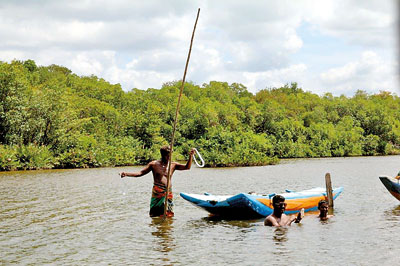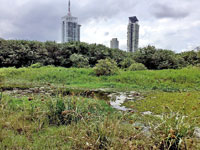Sunday Times 2
Keeping the marsh: The people-friendly approach
Wetlands give us clean air, water, food and recreational spaces. If treated right, they may even save us from future climate change
A kilometre or so from the bustling, congested sprawl of Rajagiriya lies an urban oasis. Mangrove fringed waterways, a dirt track winding through deep marsh, reedbeds swaying in the breeze and scattered everywhere evidence of non-human life — animal droppings, birds nests etc. Luxury apartment buildings tower over the Madinnagoda wetland, but the people closest to the marsh live in a parallel universe. Islands of poverty in a shrinking sea of green hemmed in by the fast expanding urbanscape of Colombo.

Fishermen: A key stakeholder in weltand conservation
For too long, wetlands were considered wastelands. I remember, as a young reporter to this newspaper almost two decades ago, writing about the first attempts to protect wetlands in and around Colombo. At this time, Attidiya, Kotte and Muthurajawela had been declared protected areas. Compromise between development needs and conservation was exemplified in the Muthurajawela development plan which allowed a portion of the vast wetland to be filled in and developed for industrial demand (the Kerawalapitiya Industrial Zone) and most of it to be conserved. Since then, however, Muthurajawela has been subjected to much abuse — municipal waste dumping, housing, power projects and even the expressway decimated the marsh and not much of it remains in its pristine state. Even the notices that declared it a protected area have been taken down.
Colombo’s wetlands received Ramsar status in 2018 — a much celebrated achievement. But protecting and conserving these lands (much of which is privately owned) has been an uphill battle for government authorities. Sometimes, according to civil society watchdog groups, both local and national government agencies are found guilty of filling and building on the marshes or using them to dump municipal or industrial waste.
Due north, the Kala Oya snakes through some of the richest mangrove areas in the country to meet the sea in a surreal landscape of sky, river, sea and lagoon. Wilpattu to its north and Aruwakkalu Forest and Puttlam lagoon to the south, the Kala Oya river mouth has a rich diversity of mangroves including the threatened Scyphiphora hydrophilacea, which is featured on a new stamp issued to commemorate World Wetlands Day 2020. A sleepy fishing village is situated on the river mouth. One would imagine that protecting such a wetland is a non-issue. But efforts to demarcate and protect this no-man’s land have been quite an uphill task in an area with uncontrolled fishery, tourism and waste dumping.

Rapid urbanisation is a major threat to Colombo Distirct's wetlands
Many attempts have been made to value wetlands. The value of an urban wetland like Madinnagoda versus the Kala Oya river mouth may be as different as chalk and cheese. The aesthetic and recreational value of urban wetlands is well known. Lesser known, however, is the role they play in flood control and purifying the water cycle.
More than 15 years ago, the value of the goods and services derived from Muthurajawela wetland was estimated by IUCN at Rs. 725 million per year. This considered the direct benefits such as fishery, flood control, water purification and tourism. Today the value of these services would easily be doubled and the population living in the wetland area would have increased tenfold. However, the marsh is still considered an expendable ‘wasteland’ to be exploited for waste dumping, haphazard industrialisation and housing.
In our attempt to conserve sensitive ecosystems that are not formally under any protection regime, the UNDP is drawing up a management plan for the Kala Oya river mouth area. It is interesting to view conservation from a user perspective — through the eyes of fishermen and farmers and tourist boat operators — who are the immediate stakeholders of this natural landscape.
Contrary to conventional conservation-oriented wisdom, communities closest to the resource are not generally the worst exploiters. Poverty ridden and marginalised, these remote and rural villagers can see the direct value of this ecosystem, and have more stakes in its conservation. The more direct benefits they derive from it for their own food and income, people are invested in conservation of nature. However, poor communities who live beside wetlands are not the only ones deriving benefit from it. Benefits spill over to the government (flood control, tourism income, water purification) to society as whole (clean air, biodiversity, recreation). If communities in the front lines are to play a key part in conservation, I strongly argue that we need to offset their risk and compensate for their loss of opportunity.
Why should this be? Imagine you are a landowner in Thalangama tank surroundings. Because it is declared an environment protection area, landowners forego the right to develop their private holdings in ways that are damaging to the environment (set up polluting industries for example) and aesthetically challenging (tall buildings). Agriculture should also desist from chemical use to the extent possible minimising threats to the fish, reptiles and plants in the wetland. While the resource is being enjoyed by many, the price of this conservation is the burden of a few.
Take another example of a paddy farmer in Colombo. Many wet zone paddies are abandoned because they are not economical and because people have other incomes. However, the UNDP has demonstrated through community grants bringing wet zone paddies back into cultivation in areas such as Homagama and Godagama. The most immediate benefit is urban flood control. The benefit, therefore, is reaped by urban dwellers and government rather than the farmer — hence we argue that there should be incentives (financial or otherwise) to encourage farmers to cultivate fallow paddies and compensate their losses from flood. If not for this natural flood interceptor, the government would be paying a heavy price to restore damaged infrastructure — and insurance payouts for homes and shops would be huge.
Coming back to Kala Oya, the UNDP’s work focuses on co-management of the natural resource with ‘users’ on the premise that those who derive direct benefit from the ecosystem have greater stake in its conservation. As such, we have managed to negotiate agreement between fishermen, tourist boat owners, Forest Department and local authorities on how to manage economic activity and recreation in this sensitive landscape with enough attention to conserving wetlands. Again, the interest and commitment of District and Divisional bureaucracy was high — this we can attribute to the approach that encouraged ‘wise use’ of natural resources instead of militarised, fortress-like conservation which shuts people out.
Food for thought, in an age where traditional conservation is increasingly challenged, the only way to stem the tide would be to take the ‘development’ approach and work with people closest to the resource.
(The writers is Policy Specialist and Team Leader, Climate Change and Environment, UNDP Sri Lanka)

